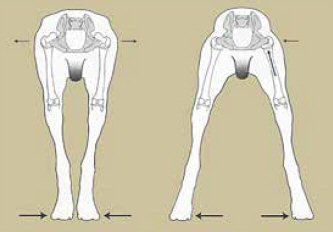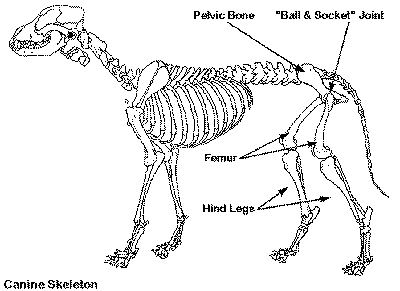The quality of life vs. winning...
 What happens if you find out that your young agility
dog has hip dysplasia. You're instructed to wait a month and then have another x-ray done.
However, the vet believes it is rather bad and that you need to consider surgery. What should
you do? Is this the end of fun for you and your dog? Dr. De Boer, the Working K-9 Vet advises
on competing with this relatively common but disturbing disorder. What happens if you find out that your young agility
dog has hip dysplasia. You're instructed to wait a month and then have another x-ray done.
However, the vet believes it is rather bad and that you need to consider surgery. What should
you do? Is this the end of fun for you and your dog? Dr. De Boer, the Working K-9 Vet advises
on competing with this relatively common but disturbing disorder.
Q. My dog has just had his preliminary hip
evaluations, and I was told he had mild-moderate hip dysplasia. In view of this, should I stop
working him?
A. For any of us that work breeds that are
prone to hip dysplasia, this can be disheartening news to say the least. Having dealt with this
question on countless occasions however, there are a number of recommendations that can be
offered to those owners in this situation.
Second opinion
First and foremost you should make sure the radiographic
evaluation is correct. If the x-rays were submitted to the OFA (Orthopedic Foundation for
Animals) or to Penn Hip, you can be reasonably confident that the evaluation is accurate.
However, if the evaluation was done by your veterinarian, and if you have any questions as to
his/her expertise in this area, it is not inappropriate to ask that the x-rays be reviewed by
veterinary radiologist, or any other veterinarian with experience in reading hip x-rays.
Different breeds have varying hip joint confirmation and unless your veterinarian is familiar
with these differences and has experience with reading hip films, there is always the
possibility that the evaluation could be better (or worse) than originally suspected. It is
important to realize that grading hips is a subjective evaluation and therefore some slight
variations in interpretation is inherent within the system.
 What next? What next?
On the presumption that the radiographic evaluation is correct, there are a number of
considerations that need to be made. The first is that this dog needs to be eliminated from any
breeding program. If we, as breeders, are to make significant progress in reducing hip
dysplasia we must constantly strive to breed only those dogs that are dysplastic free.
The second consideration that needs to be
explored is whether or not you would elect to have surgery done if the dog is an acceptable
candidate. There is a surgery that can be performed on dysplastic dogs that will help to retard
the degenerative process that typically occurs with dysplasia. The surgery is a triple pelvic
osteotomy (TPO) which will dramatically help some dogs, particularly if there is no
pre-existing degenerative change in the joint. Clearly a TPO does not change the genetics of
the situation, but it might extend the pain free longevity of the dog by virtue of slowing the
degenerative process.
Whether or not surgery is done a number
of steps should be taken to minimize the onset and magnitude of future problems. You should
keep the dogs weight down and his muscle tone up. Extra weight and poor muscle tone both
contribute to an increase in the speed of onset and the magnitude of the degenerative process
within the hip joints. Additionally it is appropriate to use the nutritional chondroprotective
agents that are available. Beyond chondroprotective agents, there is no documented evidence
that suggests that nutritional supplementation helps dysplastic dogs. In fact the scientific
information that exists shows that over supplementation with high energy foods, vitamins and
minerals can contribute to the development of hip dysplasia.
 To
work or not to work To
work or not to work
The final decision that needs to be made is whether or not to continue to work the dog. We have
to be primarily concerned with the comfort level of the dog during and after work. Whether or
not the dog is comfortable does not depend on the x-rays, but rather the hip joints themselves.
In many cases the level of change in the x-rays does not seem to have a very high correlation
to how well the dog is able to do. Careful observation and evaluation of the dog is the best
way to determine its comfort level.
Many of our working dogs have such high
drive levels that they are relatively unlikely to demonstrate significant discomfort during
work. It is more likely that you would see some signs of discomfort following work –
particularly within the first 24 hours after heavy activity. Symptoms might include difficulty
in rising after rest, a stilted gait and reluctance to go upstairs or to jump up into a
vehicle. When moving you might notice a waddling gait and if you watch the dog attempting to
trot or lope you might notice a bunny-hopping gait with the hind legs. If you notice none of
these symptoms during or after work, it is reasonably safe to say that the dogs comfort level
is satisfactory. There is virtually no way to predict how long this circumstance will persist,
but as long as it does so, it is reasonable to continue to train and trial. Clearly, you have
to realize that you could invest a considerable amount of time and energy in training and have
problems develop, but if that is a risk that you are willing to take, continuing to train is
certainly acceptable.
An argument could be made that continued
high impact on dysplastic joints could hasten the degenerative process within these joints. The
other side of that argument is that continued activity and judicious training could increase
the muscle tone and overall fitness of the dog which could lead to relatively sustained joint
health. It has been my experience that dysplastic dogs that are exercised on a regular basis
and kept at normal weights are slower to develop problems with pain than those dogs that are
inactive and overweight.
Training dysplastic dogs requires good
judgment in terms of avoiding or at least minimizing those actions that will stress the hip
joints severely. Those actions would include high-speed turns as well as exercises that would
require high levels of flexion and extension of the hip joints such as jumping. It is
particularly important with these dogs to have a training plan so that you may get the most
benefit from training with the least amount of activity. Fatigue increases the risk of problems
dramatically.
Through the years I have witnessed a
substantial number of dysplastic dogs work comfortably, enthusiastically, and over a
surprisingly lengthy interval of time. It is our responsibility however, to enter a working
program being conscious of the dogs comfort level as well as the fact that their working career
could be cut short at any time. As handlers and owners, we have an obligation not to push the
dog beyond the level at which the dog is comfortable.
 About
the author... About
the author...
Dr. Henry De Boer is the Working K-9 Vet. Following his 1973 graduation from Cornell
University, he established Pioneer Valley Veterinary Hospital, based in western Massachusetts.
His involvement with working dogs dates to the mid-1960’s
when he began training and handling hunting dogs. In 1984 he became involved with the sport of
Schutzhund and has gradually risen to the level of national competitor.
Through the years. De Boer has worked both in a training
and veterinary capacity with a wide variety of working dogs. His knowledge and enthusiasm for
working dogs led to the establishment of Working K-9 Veterinary Consultation Services. This
service provides veterinary consultations for working canines and is available by phone, fax,
or email. tel/fax: (+01) 802-254 1015. Or visit http://www.workingk-9vet.com
 Go
top Go
top
From Caroline Green...
I have just read your article on hip dysplasia in working dogs, and was very pleased
with it's advice. We have been agility training our Dalmatian for a year and she was getting
very good. However, continual lameness in her back legs drove us to the vet. He has diagnosed
dysplasia, and we are starting off with anti-inflammatories, and glucosamine.
We were trying to decide whether to carry on agility, but
having read your list of signs to look for after training, I realised she exhibits all of
these, and for a good few days after the session. Reluctantly, we have decided to stop the
agility, but I want to thank you for your excellent advice, and helping us keep our dog in a
comfortable way. Thank you again. Caroline Green & Purdy! (03/11/05)
From Toni Keating...
I have just read the article on hip dysplasia on the web site
and would like to add my own experience. I have a six year old epileptic Border Collie who has
hip dysplasia. He has always been 'stiff' but no vets had ever said dysplasia until this year
when we were referred to a rehab clinic for acupuncture for his epilepsy. The vet there works
mainly with lameness issues and uses acupuncture and a water treadmill.
On examining our dog, who had lost all muscle tone due to being overdosed on
epilepsy drugs - now sorted - she was confident he has dysplasia but we are not having it
confirmed by x ray as that would affect his epilepsy. Over the last three months that she has
treated him, we have seen amazing results. His muscles have grown, his hips are stronger and
his fits getting less and less.
We are being actively encouraged to work him as long as we warm him up and down. I cannot
stress how important it is to see an expert, ask for referrals and seek alternatives. Don't
just stop agility which most of our dogs live for! Also helps to have insurance!!
Incidentally he went Senior before we knew about the hips so it really hasn't stopped him
being successful. If either his epilepsy, hips or anything else happened to get worse, we would
stop but, at the moment, we have no plans to retire him for at least a couple of seasons. If
you'd like details of this specialist, let me know as she is very helpful and keen to help dogs
lead an active life. Toni Keating
(04/11/05)
From Janet McWilliam
I was quite interested in your page regarding hip dysplasia, but I thought that it
could do with a more practical approach on early symptoms.
I have an 18 month old Rottweiller which we found
abandoned at about 12 weeks old. After about a month, we realised that he had hip problems his
joint is like a cup and saucer. We were advised no exercise until he was one, and he had a
course of glucosamine and cartofen injections. It was very hard to stick to the no exercise
routine as he chewed everything in site, but it has really paid off we have started slowly
building his exercise back up. He has showed none of the earlier signs of discomfort.
It really makes a difference on who your vet is and
whether they believe in the advise they are giving. I think that anyone who owns a dog that has
the potential in the breed to have hip problems should choose there vet to suite the breed.
(01/03/02)
|